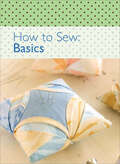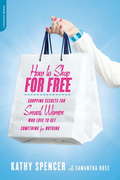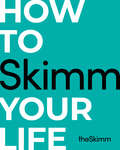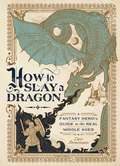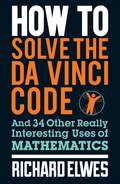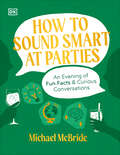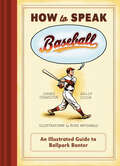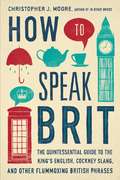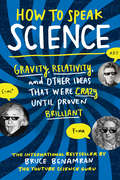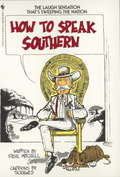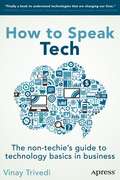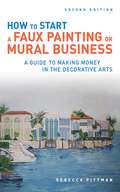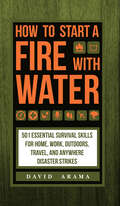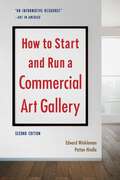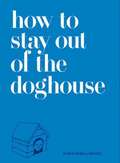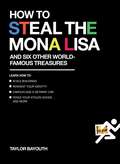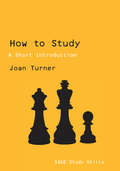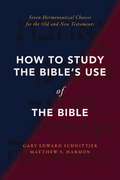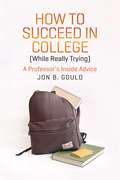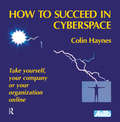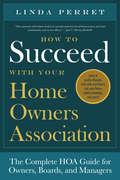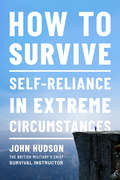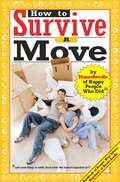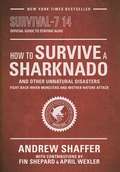- Table View
- List View
How to Sew: Basics
by The Editors of David & CharlesA brief introduction to the basics of sewing, perfect for beginners or advanced sewers interested in a refresher.This brilliant little guide covers all the essential basics of sewing, including how to choose the best fabrics and threads for projects, in clear and simple points. Learn skills in amazing sewing crafts such as cross-stitch, patchwork and quilting. This book provides all you need to know to start your own projects today, including indispensable advice for inserting zips and making and using bias bindings.
How to Shop for Free: Shopping Secrets for Smart Women Who Love to Get Something for Nothing
by Kathy SpencerFor fashionistas and carpool moms alike: a veteran super-shopperOCOs secrets for finding insider deals and working the coupons and promotions to get much of their shopping lists for free
How to Skimm Your Life
by The SkimmIt might seem like everyone you know took secret classes on budgeting, owning their career, and choosing the right wine—and you were sick that day. Enter: How to Skimm Your Life.With theSkimm’s trademark mix of real talk, humor, and inspirational messaging, this book gives you the information you need to make informed and empowered decisions in your life. Covering everything from personal finance, to career, to stress management, global politics, and more, How to Skimm Your Life breaks down some of the less glamorous parts of adulting and answers questions like:• “What’s the difference between an ETF and a mutual fund?”• “How should I negotiate my salary when I’m offered a new job?”• “Should I claim standard or itemized deductions on my taxes?”• “How should I tip while traveling abroad?”• “How do I read the wine list without breaking out a dictionary?”And much more . . . Wine & Food • Travel • Networking • Job Searching • Personal Growth • Mental Health • Time Management • Budgeting • Investing • Health Insurance • International Relations • US Government With life hacks for anyone who’s starting out in the real world, looking to make a change, or just wants a reset, How to Skimm Your Life will be time well spent—making it the perfect gift for graduation, birthdays, or your best friend “just because.”
How to Slay a Dragon: A Fantasy Hero's Guide to the Real Middle Ages
by Cait StevensonGrab your magical sword and take the place of your favorite fantasy character with this fun and historically accurate how-to guide to solving epic quests.What should you ask a magic mirror? How do you outwit a genie? Where should you dig for buried treasure? Fantasy media&’s favorite clichés get new life from How to Slay a Dragon: A Fantasy Hero&’s Guide to the Real Middle Ages, a historically accurate romp through the medieval world. Each entry presents a trope from video games, books, movies, or TV—such as saving the princess or training a wizard—as a problem for you to solve, as if you were the hero of your own fantasy quest. Through facts sourced from a rich foundation of medieval sources, you will learn how your magical problems were solved by people in the actual Middle Ages. Divided into thematic subsections based on typical stages in a fantastical epic, and inclusive of race, gender, and continent, How to Slay a Dragon is perfect if you&’re curious to learn more about the time period that inspired some of your favorite magical worlds or longing to know what it would be like to be the hero of your own mythical adventure.
How to Solve the Da Vinci Code
by Richard ElwesCan you outrun a bullet? How do you build an electronic brain? Could you slow down time? How do you unleash chaos? From Plato's classification of regular polyhedra to making a million on the stock market, How to Solve the Da Vinci Code gives you everything you need to understand how numbers work, and the impact they have on our lives every day.
How to Sound Smart at Parties: An Evening of Fun Facts & Curious Conversations
by Michael McBrideWelcome to the most interesting dinner party you&’ve ever attended!Join seven friends for an evening of trivia, myth-busting, and camaraderie. You'll have a front row seat at the party, listening in to the early small talk—where light and fun ideas are discussed (&“Did you know astronauts have Velcro on the inside of their helmets to scratch their noses?&”)—to the end of the night, when conversations get deeper. (&“Did the popularization of drinking coffee lead to modern democracies?&”)Packed with over 150 fun facts spanning the topics of ancient civilizations, animal behavior, natural science, outer space, human accomplishments, pop culture, and more, How to Sound Smart at Parties ensures you&’ll always have something clever to contribute to the conversation.
How to Speak Baseball: An Illustrated Guide to Ballpark Banter
by James Charlton Sally Cook“An elegantly designed little book . . . capturing the colorful, frequently fanciful vocabulary that describes the world of baseball.” —The Litchfield County TimesThis handsome guide to the language of baseball decodes the amusing, clever phrases that pepper commentary about the sport. Packed with witty explanations of everything from “duster” and “rubber arm” to “up the elevator,” this ballpark lexicon plays on a nostalgic love for the national pastime while covering ground from baseball’s beginnings to today. This humorous mix of definitions and anecdotes is the perfect gift for both lifelong baseball fans and rookies “working up the ranks.”“If you happen to be watching or listening to a game, do you wonder what the announcer means by ‘the neighborhood play,’ ‘can of corn’ or ‘golden sombrero?’ How to Speak Baseball: An Illustrated Guide to Ballpark Banter, by James Charlton and Sally Cook, is an informative, entertaining read. The authors have compiled a list of obscure, old and newer baseball terms from ‘ace’ to ‘you can’t walk off the island.’” —Daily Pilot
How to Speak Brit: The Quintessential Guide to the King's English, Cockney Slang, and Other Flummoxing British Phrases
by Christopher J. MooreThe quintessential A to Z guide to British English--perfect for every egghead and bluestocking looking to conquer the language barrier Oscar Wilde once said the Brits have "everything in common with America nowadays except, of course, language." Any visitor to Old Blighty can sympathize with Mr. Wilde. After all, even fluent English speakers can be at sixes and sevens when told to pick up the "dog and bone" or "head to the loo," so they can "spend a penny." Wherever did these peculiar expressions come from? British author Christopher J. Moore made a name for himself on this side of the pond with the sleeper success of his previous book, In Other Words. Now, Moore draws on history, literature, pop culture, and his own heritage to explore the phrases that most embody the British character. He traces the linguistic influence of writers from Chaucer to Shakespeare and Dickens to Wodehouse, and unravels the complexity Brits manage to imbue in seemingly innocuous phrases like "All right." Along the way, Moore reveals the uniquely British origins of some of the English language's more curious sayings. For example: Who is Bob and how did he become your uncle? Why do we refer to powerless politicians as "lame ducks"? How did "posh" become such a stylish word? Part language guide, part cultural study, How to Speak Brit is the perfect addition to every Anglophile's library and an entertaining primer that will charm the linguistic-minded legions.
How to Speak Science: Gravity, Relativity, and Other Ideas That Were Crazy Until Proven Brilliant
by Bruce BenamranAs smartphones, supercomputers, supercolliders, and AI propel us into an ever more unfamiliar future, How to Speak Science takes us on a rollicking historical tour of the greatest discoveries and ideas that make today’s cutting–edge technologies possible. Wanting everyone to be able to “speak” science, YouTube science guru Bruce Benamran explains–as accessibly and wittily as in his acclaimed videos–the fundamental ideas of the physical world: matter, life, the solar system, light, electromagnetism, thermodynamics, special and general relativity, and much more. Along the way, Benamran guides us through the wildest hypotheses and most ingenious ideas of Galileo, Newton, Curie, Einstein, and science’s other greatest minds, reminding us that while they weren’t always exactly right, they were always curious. How to Speak Science acquaints us not only with what scientists know, but how they think, so that each of us can reason like a physicist–and appreciate the world in all its beautiful chaos.
How to Speak Southern
by Steve MitchellThe laugh sensation that swept the nation, How to Speak Southern and More How to Speak Southern, is now collected in one complete--and completely hilarious--volume. Embraced by Southerners everywhere and dedicated to all Yankees in the hope that it will teach them to talk right, this uproarious book decodes "Suthun" wit and wisdom for "Nawthun" upstarts everywhere. From "aig" (a breakfast food that may be fried, scrambled, boiled, or poached) to "zackly" (as in "precisely"), here's just a sampling of what you'll find inside: ATTAIR: Contraction used to indicate the specific item desired. "Pass me attair gravy, please." EVERWHICHAWAYS: To be scattered in all directions. "You should have been there when the train hit that chicken truck. Them chickens flew everwhichaways." YONTNY: Do you want any. "Yontny more corn bread?" Funny as well as informative, this laugh-out-loud dictionary will keep you laughing and learning--no matter where you fall on the Mason-Dixon Line!
How to Speak Tech
by Vinay Trivedi"A great book everyone can use to understand how tech startups work. " --Rene Reinsberg, GM/VP at GoDaddy, CEO and Co-founder at Locu "Finally a book non-techies can use to understand the web technologies that are changing our lives. " --Paul Bottino, Executive Director, Technology and Entrepreneurship Center, Harvard University "Through the simplicity of his presentation, Vinay shows that the basics of technology can be straightforwardly understood by anyone who puts in the time and effort to learn. " --Joseph Lassiter, Professor of Management Science, Harvard Business School and Harvard Innovation Lab In a way that anyone can understand, How to Speak Tech: The Non-Techie''s Guide to Tech Basics in Business spells out the essential technical terms and technologies involved in setting up a company''s website or web application. Nontechnical business readers will find their digital literacy painlessly improved with each ten-minute chapter of this illustrative story of one successful technology startup building its Web-based business from scratch. Vinay Trivedi--a private equity analyst and startup entrepreneur who works at the intersection of business and tech--employs the startup story line as his frame for explaining in plain language the technology behind our daily user experiences, the successful strategies of social media giants, the bold aspirations of tiny startups, and the competitive adaptations of ordinary businesses of all sizes and sectors. Along the way, he demystifies all those tech buzzwords in our business culture whose precise meanings are so often elusive even to the people using them. Internet hardware, application software, and business process: the working premise of this book is that none of it is beyond the basic understanding of nontechnical business readers. Trivedi peels back the mystery, explains it all in simplest terms, and gives his readers the wherewithal to listen intelligently and speak intelligibly when the subject turns to technology in business. What you''ll learn Website hosts and programming languages for web apps on the backend Performance and scalability APIs, open-source programs, feeds, and database management Design and display on the front end Who this book is for Primary readership: nontechnical business people who want to firm up their understanding of the technology of the Internet and their fluency with technical terms in widespread use in the business world. Secondary readership: Digital immigrants in the general-interest mainstream who are looking for a short, accessible, and comprehensive treatment of Internet technology and business to inform their personal experience as consumers and generators of Internet content and value. Table of Contents Chapter 1. The Internet Chapter 2. Hosting and the Cloud Chapter 3. The Back End: Programming Languages Chapter 4. The Front End: Presentation Chapter 5. Databases: The Model Chapter 6. Leveraging Existing Code: APIs, Libraries, Web Services, and Open-Source Projects Chapter 7. Software Development: Working in Teams Chapter 8. Software Development: The Process Chapter 9. Software Development: Debugging and Testing Chapter 10. Promotion and Tracking: Attracting and Understanding Your Users Chapter 11. Performance and Scalability Chapter 12. Security Threats: To Defend and Protect
How to Start a Faux Painting or Mural Business: A Guide To Making Money In The Decorative Arts
by Rebecca F. PittmanThis second edition is updated and expanded to cover better ways to advertise, innovative supplies (such as Venetian plasters and stained cements), unique bidding and studio setups required for new plasters and varnishes, the use of the Internet both for marketing and shopping for materials, new product lines, and the latest trends in the industry. Artists ready to turn their faux, mural, and decorative painting skills into a career will find everything they need to know to start a home-based business. Readers will find insider tips on bidding and client interaction that can turn an artist into an entrepreneur. This essential guide highlights the fundamentals of getting started, from necessary office supplies to insurance needs, from building a portfolio to finding potential clients. Also covered are such crucial topics as keeping records, dealing with supply stores, getting referrals, interviewing with clients, evaluating job sites, negotiating prices, handling contracts, and coping with the growing pains of a successful business. Handy checklists and useful forms such as sample contracts, client invoices, and record-keeping charts, will help launch the business. Anyone who has ever dreamed of making money from his or her faux or mural painting, stencil, furniture decoration, and other skills must have this comprehensive resource.
How to Start a Fire with Water: 501 Essential Survival Skills for Home, Work, Outdoors, Travel, and Anywhere Disaster Strikes
by David AramaLife is unpredictable—are you prepared for it?Should disaster ever strike, you'll feel prepared with this book as your guide. Inside you'll find tips and tricks for surviving unpredictable situations at home, work, outdoors, and while traveling. From natural catastrophes such as lightning strikes, wildfire, floods, earthquakes, and tornadoes to man-made dangers such as car accidents, plane crashes, and electrical fires, this book will help you take the first steps to survival—being prepared.
How to Start and Run a Commercial Art Gallery (Second Edition)
by Edward Winkleman Patton Hindle"A comprehensive reference for any gallery owner." —Leigh Conner, director, Conner Contemporary Art Aspiring and new art gallery owners can find everything they need to plan and operate a successful art gallery with How to Start and Run a Commercial Art Gallery. This new edition has been updated to mark the changes in market and technology over the past decade. Edward Winkleman and Patton Hindle draw on their years of experience to explain step by step how to start your new venture. From finding the ideal locale and renovating the space to writing business plans and securing start-up capital, this helpful guide has it all. Chapters detail how to: Manage cash flow Grow your new business Hire and manage staff Attract and retain artists and clients Represent your artists Promote your gallery and artists online Select the right art fair And moreHow to Start and Run a Commercial Art Gallery, Second Edition, also includes sample forms, helpful tips from veteran collectors and dealers, a large section on art fairs, and a directory of art dealer associations.
How to Stay Out of the Doghouse
by Jason Musante Josh Rubin Partners SpadeAs men, we can't help ending up in the doghouse for simply following our natural instincts. But follow the 50 tips in this book, and you'll spend less time out in the cold and more time getting scratches behind the ears and belly rubs.
How to Stay Out of the Doghouse
by Partners Spade Josh Rubin Jason MusanteAn elegantly cheeky guide to keeping the woman in your life happy--while secretly doing whatever you want. Published in tandem with the woman's guide How to Keep Him on a Short Leash, How to Stay Out of the Doghouse is perfect for Father's Day.... or as a gift for a new groom.
How to Steal the Mona Lisa
by Taylor BayouthA step-by-step guide for the craft of high stakes thievery In How to Steal the Mona Lisa, author Taylor Bayouth meticulously describes seven heists of priceless art and artifacts: the Hope Diamond, the "Mona Lisa," the Archaeopteryx Lithographica, Rodin's "Thinker," King Tut's golden death mask, the Crown Jewels, and the Codex Leicester. With this trusty guide, learn to: - Camouflage a getaway car. - Hack security systems. - Navigate air ducts. - Master the art of disguise. - Pick locks, scale buildings, and more. Illustrated throughout, this book contains all the information you need to acquire equipment, recruit partners, strategize the perfect crime, and discreetly sell off your stolen national treasures.From the Trade Paperback edition.
How to Study: A Short Introduction (SAGE Study Skills Series)
by Joan TurnerAny student can improve their learning in higher education if they want to, and the aim of this guide is to help you along this route, not by claiming there is only one right way to do things but by building awareness of different approaches, attitudes, and strategies. Key to this is the notion of active learning which is highlighted throughout the book with the acronym ASCERTAIN whose individual letters signal a range of different strategies and attitudes relevant in different contexts. Throughout, there is an awareness that among the different cultures students participate in, academic culture has its own set of values which academic staff tend to take for granted, but which students may need to have a greater awareness of, and build into your thinking and working. SAGE Study Skills are essential study guides for students of all levels. From how to write great essays and succeeding at university, to writing your undergraduate dissertation and doing postgraduate research, SAGE Study Skills help you get the best from your time at university. Visit the SAGE Study Skills website for tips, quizzes and videos on study success!
How to Study the Bible's Use of the Bible: Seven Hermeneutical Choices for the Old and New Testaments
by Gary Edward Schnittjer Matthew S. HarmonHow to Study the Bible's Use of the Bible: Seven Hermeneutical Choices for the Old and New Testaments by Gary Edward Schnittjer and Matthew S. Harmon is an essential resource aimed at teaching a hermeneutic for understanding the Bible's use of the Bible. Intended for students of both testaments, the book's innovative approach demonstrates how the Old Testament use of Scripture provides resources for the New Testament authors' use of Scripture. The authors provide students with a clear approach to handling the Bible's use of itself through seven key hermeneutical choices organized into individual chapters. Each chapter introduces a hermeneutical choice and then provides several examples of the Old Testament use of Old Testament and the New Testament use of Old Testament. The plentiful examples model for students the need to ground hermeneutics in biblical evidence and provide insight into understanding why the Bible's use of the Bible is important.
How to Succeed in College: A Professor's Inside Advice (Chicago Guides To Academic Life Ser.)
by Jon B. GouldAfter years of preparation and anticipation, many students arrive at college without any real knowledge of the ins and outs of college life. They’ve been focused on finding the right school and have been carefully guided through the nuances of the admissions process, but too often they have little knowledge about how college will be different from high school or what will be expected of them during that crucial first year and beyond. Written by an award-winning teacher, How to Succeed in College (While Really Trying) provides much-needed help to students, offering practical tips and specific study strategies that will equip them to excel in their new environment. Drawing on years of experience teaching at a variety of campuses, from large research universities to small liberal arts colleges, Jon B. Gould gives readers the lay of the land and demystifies the college experience. In the course of the book, students will learn how to identify the best instructors, how to choose classes and settle on a major, how to develop effective strategies for reading and note taking, and how to write good papers and successfully complete exams. Because much of the college experience takes place outside of the classroom, Gould also advises students on how to effectively manage their cocurricular activities, work obligations, and free time, as well as how to take advantage of the typically untapped resources on every campus. With candid advice and insights from a seasoned insider, this guide will leave students better prepared not only to succeed in college but to enjoy it as well.
How to Succeed in Cyberspace
by Colin HaynesThis book is designed to help people, whether in large corporations or the smallest of enterprises, to venture with confidence into cyberspace. Written in non-technical language by a businessman for other business people, it highlights the many opportunities emerging for enterprise and personal career development.Contents: What is cyberspace?; Marketing and communicating around the world; Marketing research in cyberspace; Where to locate your business premises in both cyberspace and the real world; How to set up your cyberspace business presence; The new languages of cyberspace: how to build your business site on the web; Collecting the money; Your cyberspace business plan: don't forget the human values; Your shopping list of hardware and software products and programs; Every cyberspace entrepreneur is a publisher; Producing and packaging cyberspace disk products; New business models for the new information age; Glossary; Index.
How to Succeed with Your Homeowner's Association: The Complete HOA Guide for Owners, Boards, and Managers
by Linda M. PerretHow to Succeed with Your Homeowner’s Association is the all-inclusive handbook to help new homeowners transition into peaceful community living. This comprehensive guide explains the ins and outs of an HOA, from the structure and responsibilities to resolving disputes. Author and veteran HOA recording secretary Linda Perret doesn’t take sides—the association against the homeowner or vice versa—but rather explains how both sides are really working toward the same ultimate goal: a beautiful, peaceful neighborhood.This book answers frequently asked questions like:What is an HOA?What are the responsibilities of the homewoner?Who is the board and what do they do? What can I expect from management?How to handle disputes with the board, management, and neighbors?Perret brings over twenty years of experience working for and with various property management companies and HOA members to the table in this complete guidebook for new homeowners and HOA members alike.
How to Survive: Self-reliance In Extreme Circumstances
by John HudsonGripping stories of near disaster and survival—and the lessons to be gleaned from them—from the British military’s chief survival instructor. When faced with near death, your survival instincts kick in. Instincts can only take you so far, however; it’s preparation and planning that can make the difference between living and dying. In How to Survive, readers will hear harrowing tales of survival and learn from them. These stories are broken down and studied, whether it’s the experience of a teenager hiking to safety as the only survivor of a plane crash in the Peruvian Amazon, a fisherman drifting for more than 400 days in an open boat across the Pacific Ocean, or a US Air Force fighter pilot forced to eject from his stealth fighter thousands of feet above the earth. John Hudson, a military survivor instructor, introduces the mindset that he feels is imperative for success: the Survival Triangle. This combination of effort, hope, and goals, along with a few practical skills, provides a premade planning template that can be used to jumpstart the whole survival process.
How to Survive a Move
by Jamie Allen Kazz RegelmanIf you are one of the forty million Americans who will move this year, you know the task can seem overwhelming. Now, there's help. How to Survive A Move offers hundreds of helpful and entertaining stories on moving from the real "pros"- everyday people who have moved (many of them over a dozen times!) and survived to tell their stories.Unlike other moving books that give the opinion of one or two experts, How to Survive a Move includes words of wisdom from hundreds of people - both singles and families, nationwide - who have "been there, done that." Millions of people have survived moving, and so can you!
How to Survive a Sharknado and Other Unnatural Disasters
by Andrew ShafferSharks Are Flying at Your Head at 300 mph. How Will You Survive? In the apocalyptic world we live in, Mother Nature is angry. Danger waits at every turn, and catastrophes like the Los Angeles sharknados have taught us that we need to be ready for anything. Too many lives have already been lost. But fear not. How to Survive a Sharknado and Other Unnatural Disasters is the first and only comprehensive guide to surviving the very worst that Mother Nature can throw our way. Inside this life-saving reference, you'll find: * Vital information about dozens of unnatural disasters and ungodly monsters that can injure, maim, or kill you, from arachnoquakes and ice twisters to piranhacondas and mega pythons; * Easy-to-understand survival tips for avoiding a bloody demise; * Inspirational words of wisdom from survivors, including Fin Shepard and April Wexler; * Useful resources, such as the Shepard Survival Assessment Test (S.S.A.T), and much more. With this essential book in hand, you too can be a hero who laughs in the face of calamity while saving friends and family. Or you can just avoid getting savagely ripped apart by a robocroc. Either way, you've been warned. Now be prepared.Sharknado 2: The Second One premieres July 30 at 9/8c on Syfy!From the Trade Paperback edition.
